The root cause of many food poisoning cases and dangerous illnesses today stems from fruits and vegetables contaminated with pesticides and chemicals during cultivation. However, by washing them correctly, you can eliminate a significant amount of these toxins.
Nowadays, everyone is concerned about the risk of fruits and vegetables containing pesticides and various growth chemicals. Analysis results from market samples confirm this, not only for domestically produced produce but also for imported goods. Only by washing carefully can you hope to remove them.
Below are some washing methods recommended by health experts after testing:
1. Saltwater Combined with Cold Water

Cold water helps remove many harmful chemicals from fruits and vegetables. (Image: Internet).
According to the Center for Science and Environment (CSE, USA), 75% or more of pesticides can be removed by washing with cold water. However, for pesticides that have penetrated the inside of fruits and vegetables, removing them is quite challenging.
If possible, combine it with saltwater. Add 2 teaspoons of salt to warm water, let it cool, then soak the produce for half an hour before rinsing with cold water. This will help eliminate pesticides more effectively than just using cold water.
2. Using White Vinegar
This is a simple yet quite effective solution. Add one tablespoon of white vinegar to a bowl of warm water, soak the food for a few minutes, and then rinse with cold water.
According to the Environmental Working Group (EWG, USA), the acetic acid in white vinegar can help remove pesticide residues from the skins of fruits and vegetables, and it also kills over 90% of bacteria.
Additionally, soaking fruits and vegetables in a vinegar solution will keep them fresh longer, truly a two-in-one solution.
3. Using Baking Soda and Lemon Juice
You can prepare a simple natural washing solution by mixing 1 tablespoon of lemon juice with 2 tablespoons of baking soda in a spray bottle. Spray it on fruits and vegetables, and then rinse with cold water after a few minutes. The combination of these two ingredients will significantly clean your produce.
If you haven’t purchased baking soda yet, you can use lemon juice mixed with clean water and spray it on the fruits and vegetables. Then soak them in cold water for about 10 minutes before rinsing and drying.

If you haven’t purchased baking soda yet, you can use lemon juice mixed with clean water and spray it on the fruits and vegetables.
4. Using Lemon Essential Oil
Add 2-3 drops of natural lemon essential oil to clean water in a basin or sink, and soak the fruits and vegetables in it. Ensure that they are completely submerged in the water, then rinse with cold water after a few minutes.
5. Room Temperature Storage
For some types of fruits and vegetables, pesticides will evaporate into the air after a certain storage period, reducing the pesticide residue. For example, onions, pumpkins, carrots, and papayas can be stored at room temperature for two to three days but should not be placed directly in the refrigerator.
6. Blanching
Besides its antibacterial properties, high temperatures can evaporate and break down most pesticides. Especially for crops that are easily sprayed with systemic pesticides, it is best to chop them and blanch for about one minute after washing to ensure the pesticides dissipate. Remember to discard the blanching water and leave the lid open to allow the pesticides to evaporate with the steam.
7. Sun Exposure
According to research, when fruits and vegetables are exposed to sunlight for 5 minutes, 60% of residual organochlorine pesticides will be lost. When carrots are brought into sunlight, ultraviolet rays can break down the chemical structure of pesticides, reducing initial toxicity. The higher the temperature, the faster the pesticides evaporate.
8. Enzyme Washing Solution
Wash with an environmentally-friendly enzyme washing solution or natural vegetable washing solution. Rinse the vegetables one or two times with water to remove germs, insect eggs, and remaining pesticides on the produce.
In conclusion, fruits and vegetables are an important part of a healthy diet, but the issue of pesticide residue cannot be overlooked. Using baking soda and other methods to wash fruits and vegetables is very effective in keeping us away from the threats posed by pesticide residues and maintaining healthy eating habits.
How Much Can Washing Remove?
Of course, the effectiveness depends on each type of fruit and vegetable, the type of pesticide, and the washing method used by each person. Soft-skinned fruits, leafy greens, and certain legumes (especially snap beans) often have higher pesticide levels because they are more susceptible to insect attacks. Herbs tend to have lower pesticide levels due to their essential oils, which are natural insect repellents.
Additionally, when cooking vegetables, experts recommend opening the lid of the pot for 1-2 minutes at high temperatures to allow harmful substances to evaporate along with the steam. For some types with skins, it is best to peel them off. Thick-skinned fruits may have a lower risk of pesticide exposure.


















































